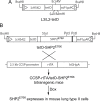SHP2E76K mutant promotes lung tumorigenesis in transgenic mice
- PMID: 24480804
- PMCID: PMC4123642
- DOI: 10.1093/carcin/bgu025
SHP2E76K mutant promotes lung tumorigenesis in transgenic mice
Abstract
Lung cancer is a major disease carrying heterogeneous molecular lesions and many of them remain to be analyzed functionally in vivo. Gain-of-function (GOF) SHP2 (PTPN11) mutations have been found in various types of human cancer, including lung cancer. However, the role of activating SHP2 mutants in lung cancer has not been established. We generated transgenic mice containing a doxycycline (Dox)-inducible activating SHP2 mutant (tetO-SHP2(E76K)) and analyzed the role of SHP2(E76K) in lung tumorigenesis in the Clara cell secretory protein (CCSP)-reverse tetracycline transactivator (rtTA)/tetO-SHP2(E76K) bitransgenic mice. SHP2(E76K) activated Erk1/Erk2 (Erk1/2) and Src, and upregulated c-Myc and Mdm2 in the lungs of bitransgenic mice. Atypical adenomatous hyperplasia and small adenomas were observed in CCSP-rtTA/tetO-SHP2(E76K) bitransgenic mice induced with Dox for 2-6 months and progressed to larger adenoma and adenocarcinoma by 9 months. Dox withdrawal from bitransgenic mice bearing magnetic resonance imaging-detectable lung tumors resulted in tumor regression. These results show that the activating SHP2 mutant promotes lung tumorigenesis and that the SHP2 mutant is required for tumor maintenance in this mouse model of non-small cell lung cancer. SHP2(E76K) was associated with Gab1 in the lung of transgenic mice. Elevated pGab1 was observed in the lung of Dox-induced CCSP-rtTA/tetO-SHP2(E76K) mice and in cell lines expressing SHP2(E76K), indicating that the activating SHP2 mutant autoregulates tyrosine phosphorylation of its own docking protein. Gab1 tyrosine phosphorylation is sensitive to inhibition by the Src inhibitor dasatinib in GOF SHP2-mutant-expressing cells, suggesting that Src family kinases are involved in SHP2 mutant-induced Gab1 tyrosine phosphorylation.
© The Author 2014. Published by Oxford University Press. All rights reserved. For Permissions, please email: journals.permissions@oup.com.
Figures





Similar articles
-
Inhibition of Shp2 suppresses mutant EGFR-induced lung tumors in transgenic mouse model of lung adenocarcinoma.Oncotarget. 2015 Mar 20;6(8):6191-202. doi: 10.18632/oncotarget.3356. Oncotarget. 2015. PMID: 25730908 Free PMC article.
-
The gain-of-function mutation E76K in SHP2 promotes CAC tumorigenesis and induces EMT via the Wnt/β-catenin signaling pathway.Mol Carcinog. 2018 May;57(5):619-628. doi: 10.1002/mc.22785. Epub 2018 Feb 8. Mol Carcinog. 2018. PMID: 29323748
-
Acquired substrate preference for GAB1 protein bestows transforming activity to ERBB2 kinase lung cancer mutants.J Biol Chem. 2013 Jun 7;288(23):16895-16904. doi: 10.1074/jbc.M112.434217. Epub 2013 Apr 23. J Biol Chem. 2013. PMID: 23612964 Free PMC article.
-
Structure, function, and pathogenesis of SHP2 in developmental disorders and tumorigenesis.Curr Cancer Drug Targets. 2014;14(6):567-88. doi: 10.2174/1568009614666140717105001. Curr Cancer Drug Targets. 2014. PMID: 25039348 Review.
-
Dual faces of SH2-containing protein-tyrosine phosphatase Shp2/PTPN11 in tumorigenesis.Front Med. 2012 Sep;6(3):275-9. doi: 10.1007/s11684-012-0216-4. Epub 2012 Aug 6. Front Med. 2012. PMID: 22869052 Review.
Cited by
-
Prevalence and role of HER2 mutations in cancer.Pharmacol Ther. 2019 Jul;199:188-196. doi: 10.1016/j.pharmthera.2019.03.010. Epub 2019 Apr 2. Pharmacol Ther. 2019. PMID: 30951733 Free PMC article. Review.
-
Shp2 promotes metastasis of prostate cancer by attenuating the PAR3/PAR6/aPKC polarity protein complex and enhancing epithelial-to-mesenchymal transition.Oncogene. 2016 Mar 10;35(10):1271-82. doi: 10.1038/onc.2015.184. Epub 2015 Jun 8. Oncogene. 2016. PMID: 26050620
-
Functions of Shp2 in cancer.J Cell Mol Med. 2015 Sep;19(9):2075-83. doi: 10.1111/jcmm.12618. Epub 2015 Jun 19. J Cell Mol Med. 2015. PMID: 26088100 Free PMC article. Review.
-
Shp2-mediated MAPK pathway regulates ΔNp63 in epithelium to promote corneal innervation and homeostasis.Lab Invest. 2020 Apr;100(4):630-642. doi: 10.1038/s41374-019-0338-2. Epub 2019 Oct 25. Lab Invest. 2020. PMID: 31653968 Free PMC article.
-
Tyrosine phosphatase PTPN11/SHP2 in solid tumors - bull's eye for targeted therapy?Front Immunol. 2024 Mar 5;15:1340726. doi: 10.3389/fimmu.2024.1340726. eCollection 2024. Front Immunol. 2024. PMID: 38504984 Free PMC article. Review.
References
-
- Tonks N.K. (2006). Protein tyrosine phosphatases: from genes, to function, to disease. Nat. Rev. Mol. Cell Biol., 7, 833–846 - PubMed
-
- Julien S.G., et al. (2011). Inside the human cancer tyrosine phosphatome. Nat. Rev. Cancer, 11, 35–49 - PubMed
-
- Xu W., et al. (1999). Crystal structures of c-Src reveal features of its autoinhibitory mechanism. Mol. Cell, 3, 629–638 - PubMed
Publication types
MeSH terms
Substances
Grants and funding
LinkOut - more resources
Full Text Sources
Other Literature Sources
Medical
Molecular Biology Databases
Research Materials
Miscellaneous

